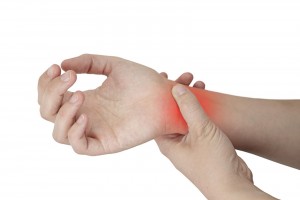Treatments for Carpal Tunnel Syndrome
 Carpal tunnel syndrome occurs when the median nerve, which runs from the forearm into the palm of the hand becomes compressed at the wrist. The carpal tunnel is a narrow passageway of ligament and bones at the base of the hand, and houses the median nerve and tendons. Swelling or thickening from irritated tendons narrows the tunnel and causes the median nerve to be compressed, which results in pain, weakness, and numbness in the hand and wrist.
Carpal tunnel syndrome occurs when the median nerve, which runs from the forearm into the palm of the hand becomes compressed at the wrist. The carpal tunnel is a narrow passageway of ligament and bones at the base of the hand, and houses the median nerve and tendons. Swelling or thickening from irritated tendons narrows the tunnel and causes the median nerve to be compressed, which results in pain, weakness, and numbness in the hand and wrist.
Symptoms of carpal tunnel syndrome can include burning, tingling, numbness, pins and needles and pain. Weakness of some muscles in the fingers, thumb and wrist can occur and if left untreated can lead to muscle atrophy.
Carpal tunnel syndrome is caused by the result of a trauma or injury to the wrist such as sprain or fracture, rheumatoid arthritis, or a mechanical problem in the wrist joint caused by work stress or a repetitive activity.
Treatments for carpal tunnel syndrome:
- REST – The initial treatment generally involves resting the affected hand and wrist for set period of time, avoiding activities that may worsen your symptoms, and wearing a wrist brace to avoid further damage from twisting or bending.
- BRACE – A removable wrist brace is often advised as a first treatment choice. The brace keeps the wrist at a neutral angle, allowing the carpal tunnel nerve to rest.
- MEDICATION – If there is inflammation, anti-inflammatory drugs such as aspirin, ibuprofen, and other nonprescription pain relievers, can reduce the swelling and pain. An injection of steroid into the carpal tunnel is an option, as steroids are known to reduce inflammation.
- THERAPIES – Acupuncture, Massage Therapy, Physiotherapy and Chiropractic treatments are beneficial for this type of injury.
- MODALITIES – Ultrasound and Laser Therapy help restore circulation, reduce inflammation, reduce swelling, muscle spasms, stiffness and pain, and speeds up the healing process at a cellular level.
- EXERCISE – Stretching exercises can strengthen your wrist and hand so that you avoid further symptoms in the future.
- SURGERY – A small operation can cut the ligament over the front of the wrist and ease the pressure in the carpal tunnel.
Initial treatments will include rest, immobilization of the wrist and ice application. Many patients will need to modify their activities and work environment, which can include adjusting keyboards, screens and chair heights, as well as modifying their workouts. These measures, as well as periodic resting and range of motion stretching exercise of the wrists provided by our physiotherapist, can help prevent the symptoms of carpal tunnel syndrome.

